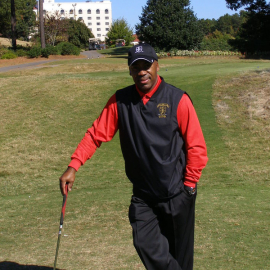
About Project Next Tee
I was born and raised in the 4600 block of Norfolk Avenue in Baltimore, Maryland. Many days, I would walk out of the back door of my home, across the back and front yards of the neighbor that lived directly behind us, and across Forest Park Avenue. As soon as I crossed the street, there was a bench at the tee box on the 15th hole of the Forest Park Golf Course. I often would sit on that bench and watch tee shot after tee shot. Yes, I literally grew up one block from a golf course. At the age of 9 or 10, I remember grabbing clubs out of an old golf bag I found in the basement, and swinging them in the backyard. I was just trying to mimic the swings of the golf pros I saw on television and the golfers I saw in person on the course at Forest Park. Years later, after entering the corporate world, I was invited by one of my clients to play in their charity golf tournament. So, at the age of 26, I took my first golf lesson to prepare for the tournament. I immediately fell in love with the game and 4 years later of playing several times a week, was an 8 handicap. After I started playing, I asked my mother about the reason for the golf clubs I found in the basement as a youngster. She told me that she took golf as a Physical Education elective when she was a sophomore in college in the mid-1950s. Instead of using the college's golf clubs, she decided to buy her own set thinking that she would continue playing. She quickly realized that golf was a very expensive sport, even for the recreational golfer. And armed with this knowledge, my parents decided it was financially easier to encourage me to play other sports than to introduce me to the expensive sport of golf. I guess living next to Forest Park Golf Course would have been very expensive for my parents because I know I would have been golfing everyday. I often wonder how good or great I would have been if I had started golfing at the age of 10.
Historically, the game of golf has been considered an elitist sport, where access to the game has been primarily limited to those with country club memberships or
access to the wealthy and influential in society. When you compare golf to other sports such as baseball, basketball, and football, a boy or girl can normally practice for hours each day and not
incur a cost for this practice. A young man or woman can go to a neighborhood basketball court or in some cases, out to their driveway to practice jump shots. A girl or boy can go outside and toss a
baseball or softball around with their mom or dad or with friends. To hit golf balls on the driving range, or to play 9 or 18 holes at any course, there is almost always a cost incurred for these
activities. Because this financial burden can be overwhelming for many parents, many of our extremely talented young athletes are not being introduced to the game of golf, and, extremely talented
golfers are not being encouraged or supported to grow their skill.
The Goal of Project Next Tee
When reflecting on my past experiences and talking with several golfers about starting Project Next Tee, I began taking a closer look at the young golfer envirnoment and the resources that are available to them. Many organizations focus on teaching young men and women character building, life management skills, and life lessons through golf; however, very few focus on developing model citizens and developing the golf skills of promising young golfers. Project Next Tee is dedicated to doing both. PNTee will support the growth of the game and business of golf by providing dedicated resources, information, and mentorships to students and their parents, which will ultimately increase player development and career participation.


